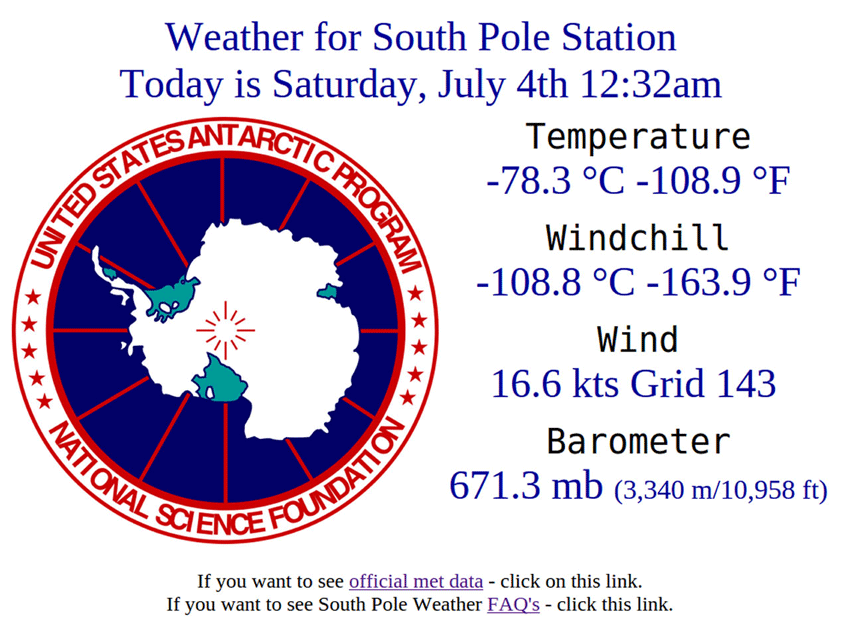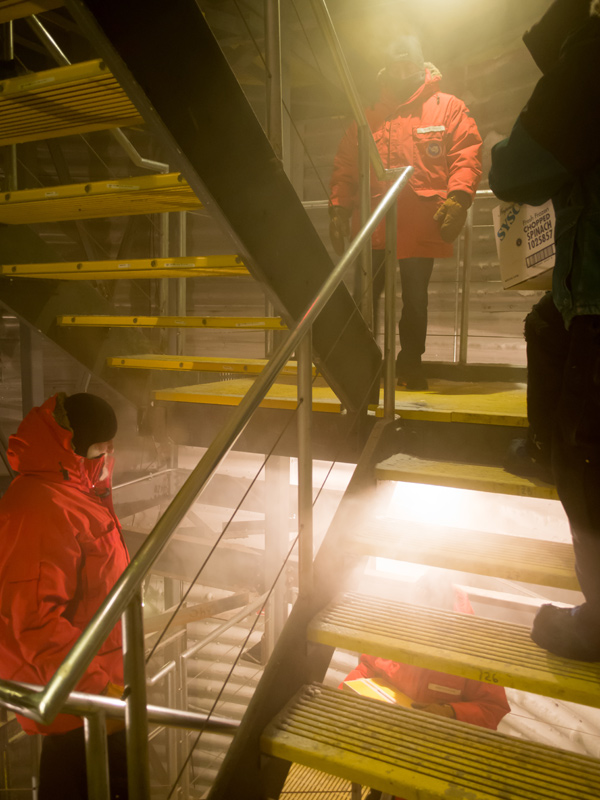
Photo Credit: Marissa Goerke
|
The moon shines brightly over the South Pole Station during the particularly chilly first week of July, 2015.
|
A Cold Week at the Pole
By Michael Lucibella, Antarctic Sun Editor
Posted August 19, 2015

It was a frosty 4th of July at the South Pole Station as temperatures hovered around minus 100 degrees Fahrenheit for eight days.
It was a frigid start to July for those wintering at the South Pole. An eight-day cold snap at the beginning of the month had temperatures hovering near minus 100 degrees Fahrenheit, with record lows recorded on seven of those days. The exceptionally cold streak kept workers busy throughout the week maintaining the station during such extreme temperatures.
“The maintenance staff, along with a good number of hearty individuals who volunteered to brave the elements and help out, were truly the heroes of that cold stretch,” said John O’Connor, the winter site manager at the South Pole Station.
Temperatures first started to dip sharply on July 2, plunging from around minus 90 to minus 105 degrees Fahrenheit over the course of the day. The following day was the coldest of the year so far.
“We got down to minus 109.1 the evening of July 3rd and, just sitting in my office, I could hear the metal sheeting on the outside of the station ‘popping’ as it contracted with the cold,” O’Connor said.
Plunging temperatures in several of the station’s ancillary buildings set off multiple low temperature alerts over the course of the week. The extended period of extreme cold caused the normally liquid fuel to thicken into a jelly-like consistency, gumming up the gas lines of the heaters and boilers used to warm the buildings. Repair crews spent much of the Fourth of July, and significant portions of the rest of the week, warming gas lines and installing insulation to get fuel flowing again.
“The maintenance staff worked from very early in the morning until very late at night on what was supposed to be a day off,” O’Connor said.
Gelled fuel also stopped up the Vehicle Fueling Module, the South Pole’s main fueling station. To keep the heaters and boilers gassed up, workers transported 55-gallon drums of warm fuel from the station’s main power plant to the smaller tanks in the outlying buildings,
“[The cold spell] showed us a couple of weak points that we can work on and fix, but [there was] no permanent damage to anything,” said Weeks Heist, the facilities engineer for South Pole Station.
Clint Perrone, the senior meteorologist at the South Pole, said that the frigid temperatures were brought about by a large mass of cold air that lingered over the region.
“The weather during the time of the cold temperatures was the result of a deep low-pressure system that moved over the region and seemed to be blocked off and became stagnant,” Perrone said. “As it settled over the polar plateau, it deepened, and as a result, it got colder and colder.”
The low-pressure system also made the air even thinner than usual. The South Pole station sits on a plateau about 9,300 feet above sea level, but because the Earth’s atmosphere is thinner at the poles and thicker at the equator, the air pressure at the South Pole seems more like 10,500 feet on an average day. The low-pressure system dropped the pressure even farther, so the “physio-altitude,” how high up it feels, was equal to 11,600 feet.
“So basically it felt like we were 1,100 feet higher than normal, which can cause people to feel more sluggish or can make it a bit harder to breathe,” Perrone said.
Jesse Milton, the station chief at the National Oceanic and Atmospheric Administration’s South Pole Atmospheric Research Observatory, said that though the week was unusually cold, it did not run counter to the prevailing theories about climate change. “Eight days of record-setting cold at the South Pole is not enough evidence to determine climate trends in Antarctica,” Milton said.
Perrone added that a streak akin to this one usually happens once every couple of years. Most of the records set were only a few tenths of degrees below previous records from the last 30 years.
“The winds associated with the cold [are] somewhat more unusual,” Perrone said. “Normally the winds are quite calm when it gets that cold and they are almost always straight out of the east. To see the winds come from the southeast is a bit less common … we don’t even see that when it’s not that cold.”
At its peak, the wind was blowing at about 25 miles per hour, dropping the wind chill to minus 170 degrees Fahrenheit.
“If you had any skin exposed while outside in that kind of wind chill it would feel like you put that piece of skin on a hot stove,” Perrone said. “In other words, it burns, and it starts burning real quick!”

Photo Credit: John O’Connor
South Pole residents help haul food up the 92 steps inside the station’s vertical tower after the elevator from the food storage area was shut down due to the cold.
Workers bundled under extra layers to brave the icy temperatures outside. When repair crews tended to a low temperature alert at the satellite communications building, they drove the three-quarters of a mile to the structure for added safety. Vehicles are only used in emergency situations below about minus 65 degrees Fahrenheit because of the toll it takes on the machines.
Back at the main station, the cold affected a few of the smaller systems as well.
“Our elevator that we use to bring food from the storage to the galley was inoperable at those temperatures, so everyone came together and hauled a few weeks’ worth of food up the 92 steps,” Perrone said. “Trying [to] make a daisy chain up the stairs in very cold temps and high physio altitudes was pretty daunting, even though we weren’t really walking up and down the stairs; the simple movement of handing over boxes was tiring enough.”
Despite the challenging conditions, Pole residents kept a positive attitude throughout the week.
“The food pull really turned into a community ‘event’ and folks had a good time doing it,” O’Connor said. “The crew (even the old-timers here), embraced [the cold snap] with a sense of adventure, and the realization that we were privileged to experience something few people would ever get to experience.”







